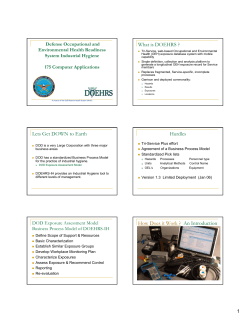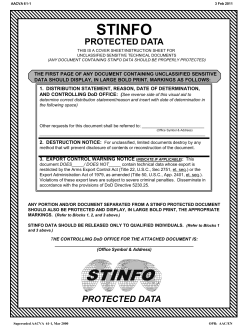
DoD Funding Presentation - BSD Office of Faculty Affairs
Pursuing New Research Opportunities Within The Department of Defense April 28, 2015 Kate Von Holle – Director, Federal Research Development Office of Federal Relations, Washington DC ¨ Aims 1) 2) To familiarize you with some of the funding mechanisms offered by the Department of Defense To demonstrate how the Office of Federal Relations can help plug you into the DOD machine Support the work of the University by identifying or creating opportunities to promote University interests to the White House, executive branch agencies, members of Congress, and other national opinion leaders and stakeholders Identifying Sources of Federal Funding } Influencing Policy/Funding Process* } ◦ *You can do this with the DOD } Elevating Ideas to a National Level DOD Key Things to Remember } 6.1, 6.2, 6.3 – what are these numbers? ◦ Basic, applied, and advanced technology development } Funding Levels- FY15 (in Billions) ◦ Proposed: 6.1 – $2.02, 6.2 - $4.46, 6.3 - $5.04 ◦ Enacted: 6.1 - $2.279, 6.2: $4.605; 6.3: $5.530 billion ◦ Total for 6.1 and 6.2=$6.884 } Not your typical funding mechanism ◦ “Basic Research with a Purpose” – need DOD relevance ◦ Need to link to a mission or domains, even with basic research (more later) } } } DOD is a massive, interconnected, yet stovepiped machine! I do not know everything about every single program (but neither does anybody else, including DOD employees!) Each program/agency/funder/Department is unique and requires a different approach 5 } } } } } } } } } Army Research Office Office of Naval Research Air Force Office of Scientific Research DARPA IARPA US Army Medical Research and Materiel Command (MRMC) and US Army Medical Research Acquisition Authority (MRAA) Congressionally Directed Medical Research Program US Army Research Institute for the Behavioral and Social Sciences (ARI) Minerva Initiative – overarching DOD *I am excluding the DOD research labs Army Research Office – Five Year BAA } Office of Naval Research – Specific BAA’s only } Air Force Office of Scientific Research – Open } ◦ General BAA’s issued to describe the particular S&T focus areas for that service branch ◦ Points of contact for each area are usually provided ◦ Funding size ranges from $250,000-$1.5 - very commonly in the $700,000 range } Topic-specific BAA’s can also be issued for these funders } DARPA & IARPA– issues general office BAA’s (BTO, DSO, etc…) ◦ no money attached, just issue areas } DARPA & IARPA– also issue specific programlevel BAA’s Deadlines included Monetary amounts for the program generally not specified } Other DOD offices/programs can issue specific BAA’s for specific programs ◦ Example - ONR has a STEM BAA DARPA, IARPA run programs differently, } Some require a white paper/pre-proposal stage, some do not } ◦ Funding sizes are larger (millions of dollars) ◦ Many program officers/directors are rotators ◦ Three year contracts – strong milestones ◦ More reporting than normal ◦ Funding can be rescinded! ◦ Workshops, Proposers Days, Solicitation Cannot talk to a program officer once solicitation is live ◦ Some biomedical work (two examples) 9 } DARPA/BTO ◦ Technologies for Host Resilience (THoR) – open (June 9 – no white paper) ◦ Seeks to discover host tolerance mechanisms in order to identify a suite of interventions suitable for use in humans to mitigate the deleterious effects of infectious diseases. THoR is seeking novel methods and technologies to discover and understand these responses in hosts that are resilient when exposed to infectious diseases. Specifically, DARPA aims to discover the fundamental biological relationships that underlie host tolerance to infection in animal populations in order to provide the foundational knowledge required to develop interventions for potential transition into clinical use. This program is organized into three Technical Areas (Tas). This BAA will focus specifically on understanding tolerance mechanisms in prospective animal studies in conjunction with the analysis of retrospective preclinical and human clinical datasets. } IARPA ◦ Machine Intelligence from Cortical Networks (MICrONS) – closed ◦ The MICrONS program aims to achieve a quantum leap in machine learning by creating novel machine learning algorithms that use neurally-inspired architectures and mathematical abstractions of the representations, transformations, and learning rules employed by the brain. 10 Credited to George Heilmeier – former Director of DARPA 1. What are you trying to do? Why is it hard? Articulate your objectives using no jargon 2. How is it done today? What are the limits of current practice? 3. What is new in your approach and why do you think it will be successful? 4. Who cares? 5. If your successful, what difference will it make? (What impact will success have?) 6. What are the risks and payoffs? 7. How much will it cost? 8. How long will it take? 9. What are the midterm and final “exams” to check for success? (i.e. how will progress be measured) } 11 DARPA’s new theme – think 20 years out, project should change the world, and a large percentage of the population should care } Pitch ideas to program directors } ◦ can take some effort and more than one visit } Ultimate Goal -get invited to workshops where the proposals are being developed ◦ Second best option – attend Proposers days. After workshops, still useful 12 1) Find out as much as you can about the opportunity you are interested in 2) Shop the idea if possible–write a two pager 3) Engage early (before solicitation comes out if possible) 4) Think long-term ◦ Specific BAA’s – some are yearly so think ahead and engage after the current solicitation is over 13 5) Participate in the white paper stage, if offered 6) ALWAYS contact a program officer before submitting anything, if possible ◦ Ask me for help if needed ◦ Exceptions If you can’t talk to the program officer – you can still submit questions online 7) Be mindful on timing ◦ Look carefully – white paper deadlines (if applicable) are listed before full proposal deadlines 14 } READ the solicitation carefully! ◦ Tend to be very focused } Link your idea to the stated mission ◦ Missions or domains are nearly always specifically listed } If you don’t know how your idea could relate to the requirements, then ask ◦ Program officers can help ◦ “The DOD should be interested in this” is not a valid explanation 15 Grants.gov, and FedBizOpps } Read the BAA’s, check deadlines } ◦ Vary from year to year but are somewhat consistent } Engage Program officers early – see what might be new in the upcoming BAA ◦ Develop relationships!!! } Help from Office of Federal Relations ◦ Reactive and Proactive work ◦ Reactive – I can send opportunities as I see them (for specific faculty as well as to Hannah) ◦ Proactive – See programs, explore on my own and send back Congressionally Directed Medical Research Program (CDMRP) } Overlap with NIH - intended } Funding is not included in the Presidential Budget } ◦ Separate, line item requests } No contact with Program Officers ◦ Possible exceptions, still exploring } OFR is currently working with Senator Durbin’s office to explore expansion of topics 17 } } DOD is difficult to understand and navigate Not everyone will have research that will be suited for DOD opportunities BUT! } There are funding opportunities for some faculty if they are willing to engage and be flexible 18 Contact info: kvonholle@uchicago.edu 19
© Copyright 2025









